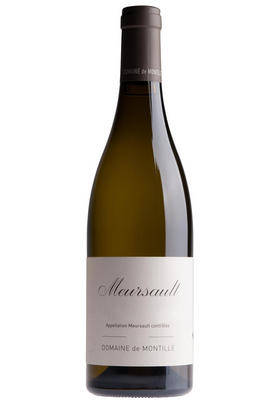
2017 Meursault, Saint-Christophe, Domaine de Montille, Burgundy

Critics reviews
William Kelley - 31/01/2019
About this WINE

Domaine de Montille
The De Montille family has long been a venerable one in Burgundy, though Domaine de Montille’s reputation was properly established in 1947: prominent Dijon lawyer Hubert de Montille inherited 2.5 hectares in Volnay, later adding further parcels in Volnay, Pommard and Puligny. Hubert’s style was famously austere: low alcohol, high tannin and sublime in maturity.
His son, Etienne, joined him from ’83 to ’89 before becoming the senior winemaker, taking sole charge from ’95. Etienne also managed Château de Puligny-Montrachet from ’01; he bought it, with investors, in ’12.
The two estates were separate until ’17, when the government decreed that any wine estate bearing an appellation name could no longer offer wine from outside that appellation.
The solution was to absorb the château estate into De Montille – the amalgamated portfolio is now one of the finest in the Côte d’Or.
Etienne converted the estate to organics in ‘95, and to biodynamics in 2005, making the house style more generous and open, focusing on the use of whole bunches for the reds.

Meursault
There are more top producers in Meursault than in any other commune of the Côte d’Or. Certainly it is the most famous and popular of the great white appellations. Its wines are typically rich and savoury with nutty, honeyed hints and buttery, vanilla spice from the oak.
Even though it is considerably larger than its southerly neighbours Chassagne and Puligny, Meursault contains no Grands Crus. Its three best Premiers Crus, however – Les Perrières, Les Genevrières and Les Charmes – produce some of the region’s greatest whites: they are full, round and powerful, and age very well. Les Perrières in particular can produce wines of Grand Cru quality, a fact that is often reflected in its price. Meursault has also been one of the driving forces of biodynamic viticulture in the region, as pioneered by Lafon and Leflaive.Many of the vineyards below Premier Cru, known as ‘village’ wines, are also well worth looking at. The growers vinify their different vineyard holdings separately, which rarely happens in Puligny or Chassagne. Such wines can be labelled with the ‘lieu-dit’ vineyard alongside (although in smaller type to) the Meursault name.
Premier Cru Meursault should be enjoyed from five to 15 years of age, although top examples can last even longer. Village wines, meanwhile, are normally at their best from three to 10 years.
Very occasionally, red Meursault is produced with some fine, firm results. The best red Pinot Noir terroir, Les Santenots, is afforded the courtesy title of Volnay Santenots, even though it is actually in Meursault.
- 305 hectares of village Meursault. The best vineyards include Clos de la Barre, Tesson, Chevalières, Rougeot, Narvaux
- 132 hectares of Premier Cru vineyards (17 in all). The finest vineyards include Les Perrières, Les Genevrières and Les Charmes
- Recommended producers: Comte Lafon, Arnaud Ente, Coche Dury, Guy Roulot, Jean-Philippe Fichet, Patrick Javillier, François Jobard, Michel Bouzereau
- Recommended restaurant: Le Chevreuil

Chardonnay
Chardonnay is often seen as the king of white wine grapes and one of the most widely planted in the world It is suited to a wide variety of soils, though it excels in soils with a high limestone content as found in Champagne, Chablis, and the Côte D`Or.
Burgundy is Chardonnay's spiritual home and the best White Burgundies are dry, rich, honeyed wines with marvellous poise, elegance and balance. They are unquestionably the finest dry white wines in the world. Chardonnay plays a crucial role in the Champagne blend, providing structure and finesse, and is the sole grape in Blanc de Blancs.
It is quantitatively important in California and Australia, is widely planted in Chile and South Africa, and is the second most widely planted grape in New Zealand. In warm climates Chardonnay has a tendency to develop very high sugar levels during the final stages of ripening and this can occur at the expense of acidity. Late picking is a common problem and can result in blowsy and flabby wines that lack structure and definition.
Recently in the New World, we have seen a move towards more elegant, better- balanced and less oak-driven Chardonnays, and this is to be welcomed.


Buying options
Add to wishlist
Description
Initially offered as “Sur le Coteau” in 2016, this wine comes from the climats of Casse-Tête, Les Petits Charrons (both from Château de Puligny) and Narvaux du Dessous (from De Montille). These three terroirs are perfectly sited in the middle of the hillside of Meursault, also known as the Montagne St Christophe. This class shines through, with perfect weight, bright acidity and a long, fine finish. Drink 2021 - 2028.
Winemaker Brian Sieve draws comparisons between the white wines of 2017 and 2014, explaining that the texture, weight and freshness are very similar in both years, although 2017 has perhaps a little more fruit ripeness, along with excellent tension and persistence. He believes that this same freshness and brightness in the reds will provide ageing capacity, pointing out that they worked hard to restrict the yield of Pinot Noir to achieve riper grapes. Overall slightly less whole-bunch fermentation was used as Brian felt the stems and fruit were not as ripe as in richer vintages.
wine at a glance
Delivery and quality guarantee